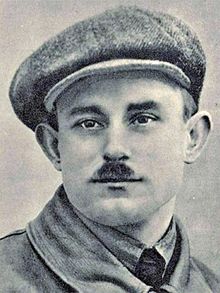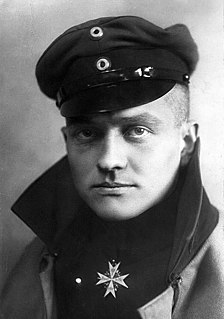
Manfred Albrecht Freiherr von Richthofen, known in English as Baron von Richthofen, was a fighter pilot with the German Air Force during World War I. He is considered the ace-of-aces of the war, being officially credited with 80 air combat victories.

The Fokker D.VII was a German World War I fighter aircraft designed by Reinhold Platz of the Fokker-Flugzeugwerke. Germany produced around 3,300 D.VII aircraft in the second half of 1918. In service with the Luftstreitkräfte, the D.VII quickly proved itself to be a formidable aircraft. The Armistice ending the war specifically required, as the fourth clause of the "Clauses Relating to the Western Front", that Germany was required to surrender all D.VIIs to the Allies. Surviving aircraft saw much service with many countries in the years after World War I.

The Fokker Scourge occurred during the First World War from July 1915 to early 1916. Imperial German Flying Corps units, equipped with Fokker Eindecker fighters, gained an advantage over the Royal Flying Corps (RFC) and the French Aéronautique Militaire.
Albatros Flugzeugwerke GmbH was a German aircraft manufacturer best known for supplying the German airforces during World War I.

Dr. Ernst Heinkel was a German aircraft designer, manufacturer, Wehrwirtschaftsführer in the Third Reich, and member of the Nazi party. His company Heinkel Flugzeugwerke produced the Heinkel He 178, the world's first turbojet aircraft and jet plane, and the Heinkel He 176, the first rocket aircraft.

The Albatros C.III was a German two-seat general-purpose biplane of World War I, built by Albatros Flugzeugwerke. The C.III was a refined version of the successful Albatros C.I and was eventually produced in greater numbers than any other C-type Albatros.

The Albatros C.I,, was the first of the successful C-series of two-seat general-purpose biplanes built by Albatros Flugzeugwerke during World War I. Based on the unarmed Albatros B.II, the C.I reversed the pilot and observer seating so that the observer occupied the rear cockpit which was fitted with a ring-mounted 7.92 mm (0.312 in) Parabellum MG14 machine gun.

The Albatros B.II, was an unarmed German two-seat reconnaissance biplane of the First World War.
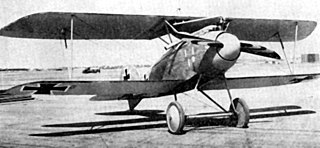
The Albatros D.III was a biplane fighter aircraft used by the Imperial German Army Air Service (Luftstreitkräfte) during World War I. A modified licence model was built by Oeffag for the Austro-Hungarian Air Service (Luftfahrtruppen). The D.III was flown by many top German aces, including Wilhelm Frankl, Erich Löwenhardt, Manfred von Richthofen, Karl Emil Schäfer, Ernst Udet, and Kurt Wolff, and Austro-Hungarian ones, like Godwin von Brumowski. It was the preeminent fighter during the period of German aerial dominance known as "Bloody April" 1917.

LeutnantKarl Allmenröder was a German World War I flying ace credited with 30 aerial victories. The medical student son of a preacher father was seasoned in the trenches as an 18-year-old artilleryman in the early days of the First World War, earning promotion via battlefield commission to Leutnant on 30 March 1915. After transferring to aviation and serving some time as an artillery spotter in two-seater reconnaissance airplanes, he transferred to flying fighter aircraft with Jagdstaffel 11 in November 1916. As Manfred von Richthofen's protege, Karl Allmenröder scored the first of his 30 confirmed victories on 16 February 1917. Flying a scarlet Albatros D.III trimmed out with white nose and elevators, Allmenröder would score a constant string of aerial victories until 26 June 1917, the day before his death. On 27 June 1917, Karl Allmenrö
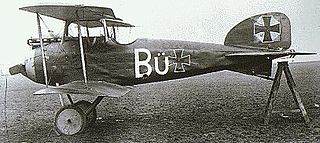
The Albatros D.I was a German fighter aircraft used during World War I. Although its operational career was short, it was the first of the Albatros D types which equipped the bulk of the German and Austrian fighter squadrons (Jagdstaffeln) for the last two years of the war.
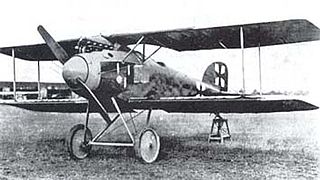
The Albatros D.II was a German fighter aircraft used during World War I. After a successful combat career in the early Jagdstaffeln, it was gradually superseded by the Albatros D.III.

Amelie Hedwig Boutard-Beese, also known as Melli Beese, was an early German female aviator.

The Albatros B.I, was a German military reconnaissance aircraft designed in 1913 and which saw service during World War I.

The Albatros J.II was a German single-engine, single-seat, biplane ground-attack aircraft of World War I.

The Halberstadt D.II was a biplane fighter aircraft developed and manufactured by German aircraft company Halberstädter Flugzeugwerke.

The Hannover CL.II was an escort fighter, produced in Germany during World War I, designed in response to a 1917 requirement by the Idflieg for such a machine to protect reconnaissance aircraft over enemy territory. It was a compact biplane of largely conventional configuration with single-bay staggered wings of unequal span. The fuselage was a thin plywood paneled, wooden monocoque design, very similar to the style of fuselage in Robert Thelen's Albatros series of single-seat fighters.

A Jagdstaffel was a fighter Staffel (squadron) of the German Imperial Luftstreitkräfte during World War I.

Jasta 2 was one of the best-known German Luftstreitkräfte Squadrons in World War I. Its first commanding officer was the great aerial tactician Oswald Boelcke, and it was the incubator of several notable aviation careers.
Offiziersstellvertreter Edmund Nathanael was a World War I flying ace credited with 15 aerial victories. He flew both two-seater reconnaissance aircraft and single-seater fighter craft. He scored all his victories while flying for Royal Prussian Jagdstaffel 5, and received a rare award of the House Order of Hohenzollern for his valor. He was killed in action while serving the German Empire.
